An Analysis of HRD Issues, Solutions, and Evaluation at Thornlea
VerifiedAdded on 2020/10/04
|10
|2332
|37
Essay
AI Summary
This essay provides a comprehensive analysis of Human Resource Development (HRD) issues within the organization Thornlea, focusing on poor communication and autocratic leadership styles as key challenges. The report explores the impact of these issues on employee performance and organizational success. It then proposes solutions, including the adoption of participative leadership and improved communication strategies. The development of training materials is discussed, with an emphasis on the Kirkpatrick's four-level training evaluation model to measure the effectiveness of training programs. The strengths and weaknesses of this model are assessed, followed by specific recommendations to address the identified HRD problems. The essay underscores the importance of skilled employees and effective HRD practices in achieving organizational objectives, offering insights into enhancing employee skills, improving communication, and fostering a positive work environment.
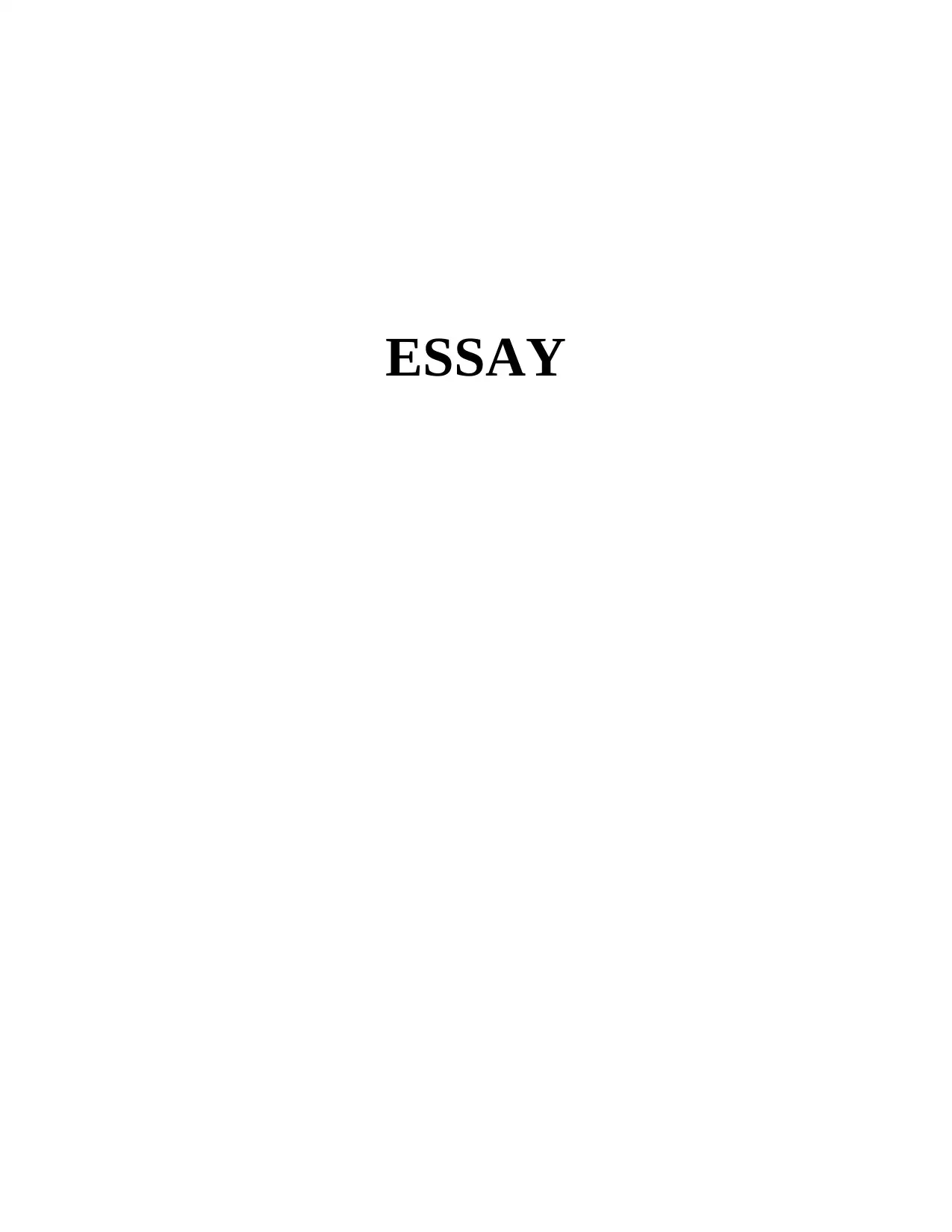
ESSAY
Paraphrase This Document
Need a fresh take? Get an instant paraphrase of this document with our AI Paraphraser
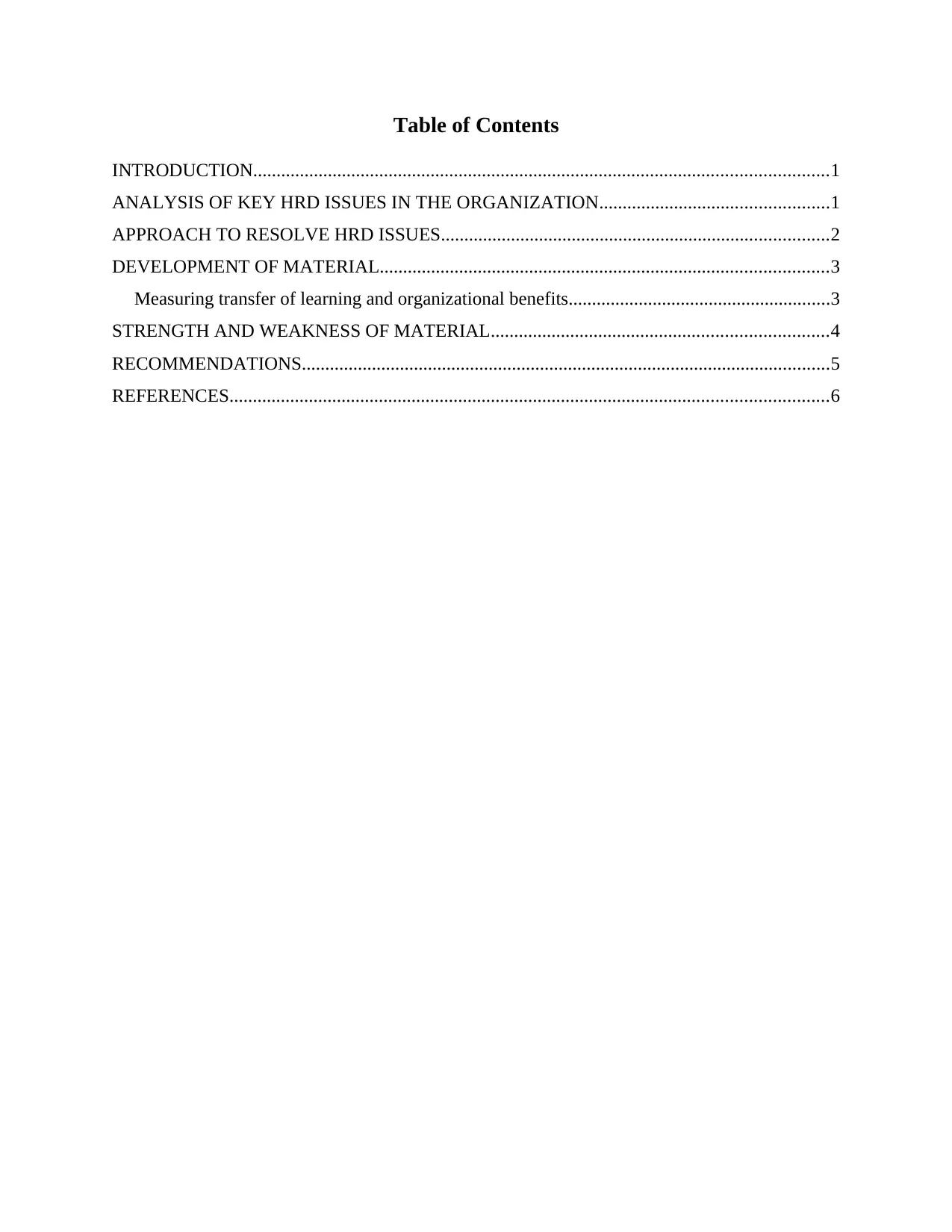
Table of Contents
INTRODUCTION...........................................................................................................................1
ANALYSIS OF KEY HRD ISSUES IN THE ORGANIZATION.................................................1
APPROACH TO RESOLVE HRD ISSUES...................................................................................2
DEVELOPMENT OF MATERIAL................................................................................................3
Measuring transfer of learning and organizational benefits........................................................3
STRENGTH AND WEAKNESS OF MATERIAL........................................................................4
RECOMMENDATIONS.................................................................................................................5
REFERENCES................................................................................................................................6
INTRODUCTION...........................................................................................................................1
ANALYSIS OF KEY HRD ISSUES IN THE ORGANIZATION.................................................1
APPROACH TO RESOLVE HRD ISSUES...................................................................................2
DEVELOPMENT OF MATERIAL................................................................................................3
Measuring transfer of learning and organizational benefits........................................................3
STRENGTH AND WEAKNESS OF MATERIAL........................................................................4
RECOMMENDATIONS.................................................................................................................5
REFERENCES................................................................................................................................6
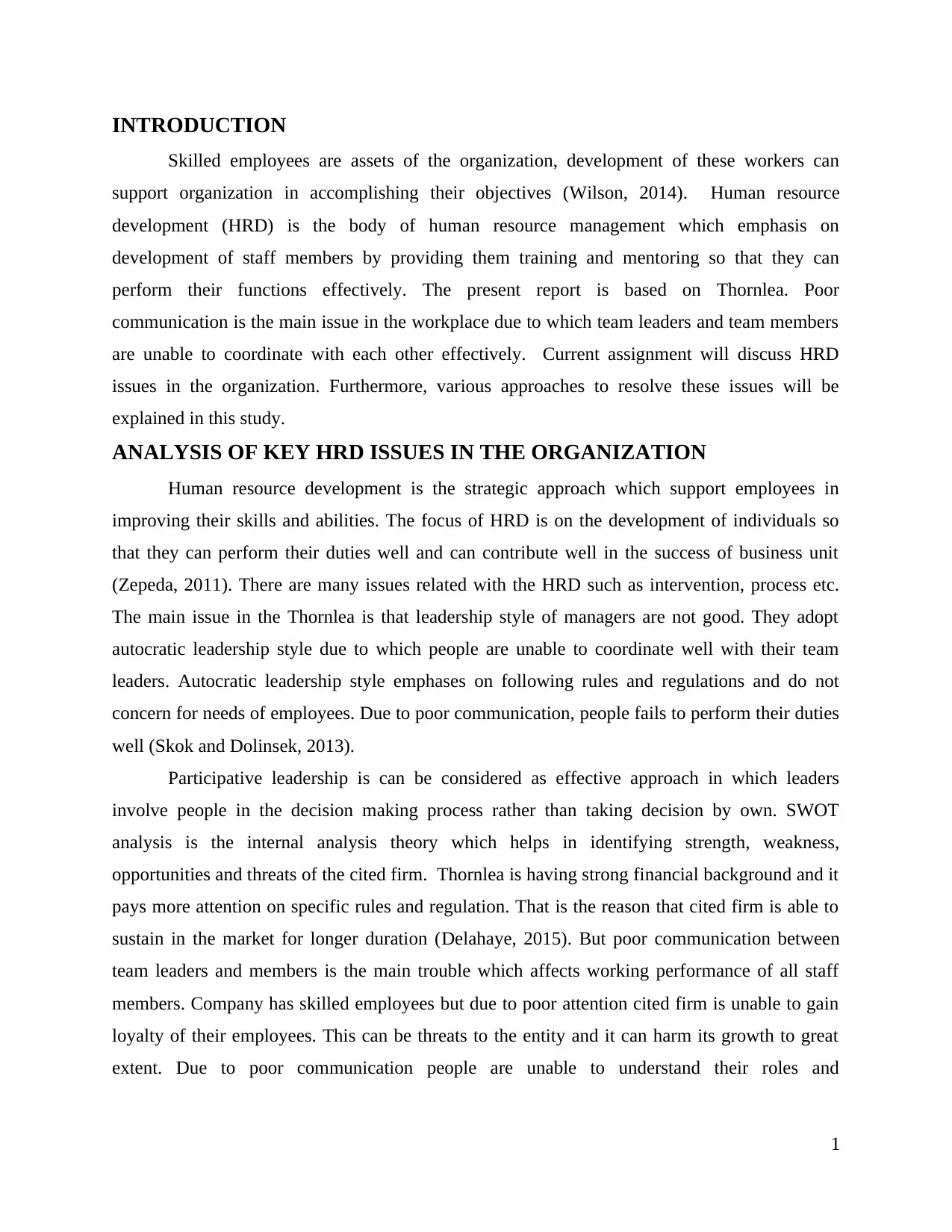
INTRODUCTION
Skilled employees are assets of the organization, development of these workers can
support organization in accomplishing their objectives (Wilson, 2014). Human resource
development (HRD) is the body of human resource management which emphasis on
development of staff members by providing them training and mentoring so that they can
perform their functions effectively. The present report is based on Thornlea. Poor
communication is the main issue in the workplace due to which team leaders and team members
are unable to coordinate with each other effectively. Current assignment will discuss HRD
issues in the organization. Furthermore, various approaches to resolve these issues will be
explained in this study.
ANALYSIS OF KEY HRD ISSUES IN THE ORGANIZATION
Human resource development is the strategic approach which support employees in
improving their skills and abilities. The focus of HRD is on the development of individuals so
that they can perform their duties well and can contribute well in the success of business unit
(Zepeda, 2011). There are many issues related with the HRD such as intervention, process etc.
The main issue in the Thornlea is that leadership style of managers are not good. They adopt
autocratic leadership style due to which people are unable to coordinate well with their team
leaders. Autocratic leadership style emphases on following rules and regulations and do not
concern for needs of employees. Due to poor communication, people fails to perform their duties
well (Skok and Dolinsek, 2013).
Participative leadership is can be considered as effective approach in which leaders
involve people in the decision making process rather than taking decision by own. SWOT
analysis is the internal analysis theory which helps in identifying strength, weakness,
opportunities and threats of the cited firm. Thornlea is having strong financial background and it
pays more attention on specific rules and regulation. That is the reason that cited firm is able to
sustain in the market for longer duration (Delahaye, 2015). But poor communication between
team leaders and members is the main trouble which affects working performance of all staff
members. Company has skilled employees but due to poor attention cited firm is unable to gain
loyalty of their employees. This can be threats to the entity and it can harm its growth to great
extent. Due to poor communication people are unable to understand their roles and
1
Skilled employees are assets of the organization, development of these workers can
support organization in accomplishing their objectives (Wilson, 2014). Human resource
development (HRD) is the body of human resource management which emphasis on
development of staff members by providing them training and mentoring so that they can
perform their functions effectively. The present report is based on Thornlea. Poor
communication is the main issue in the workplace due to which team leaders and team members
are unable to coordinate with each other effectively. Current assignment will discuss HRD
issues in the organization. Furthermore, various approaches to resolve these issues will be
explained in this study.
ANALYSIS OF KEY HRD ISSUES IN THE ORGANIZATION
Human resource development is the strategic approach which support employees in
improving their skills and abilities. The focus of HRD is on the development of individuals so
that they can perform their duties well and can contribute well in the success of business unit
(Zepeda, 2011). There are many issues related with the HRD such as intervention, process etc.
The main issue in the Thornlea is that leadership style of managers are not good. They adopt
autocratic leadership style due to which people are unable to coordinate well with their team
leaders. Autocratic leadership style emphases on following rules and regulations and do not
concern for needs of employees. Due to poor communication, people fails to perform their duties
well (Skok and Dolinsek, 2013).
Participative leadership is can be considered as effective approach in which leaders
involve people in the decision making process rather than taking decision by own. SWOT
analysis is the internal analysis theory which helps in identifying strength, weakness,
opportunities and threats of the cited firm. Thornlea is having strong financial background and it
pays more attention on specific rules and regulation. That is the reason that cited firm is able to
sustain in the market for longer duration (Delahaye, 2015). But poor communication between
team leaders and members is the main trouble which affects working performance of all staff
members. Company has skilled employees but due to poor attention cited firm is unable to gain
loyalty of their employees. This can be threats to the entity and it can harm its growth to great
extent. Due to poor communication people are unable to understand their roles and
1
⊘ This is a preview!⊘
Do you want full access?
Subscribe today to unlock all pages.

Trusted by 1+ million students worldwide
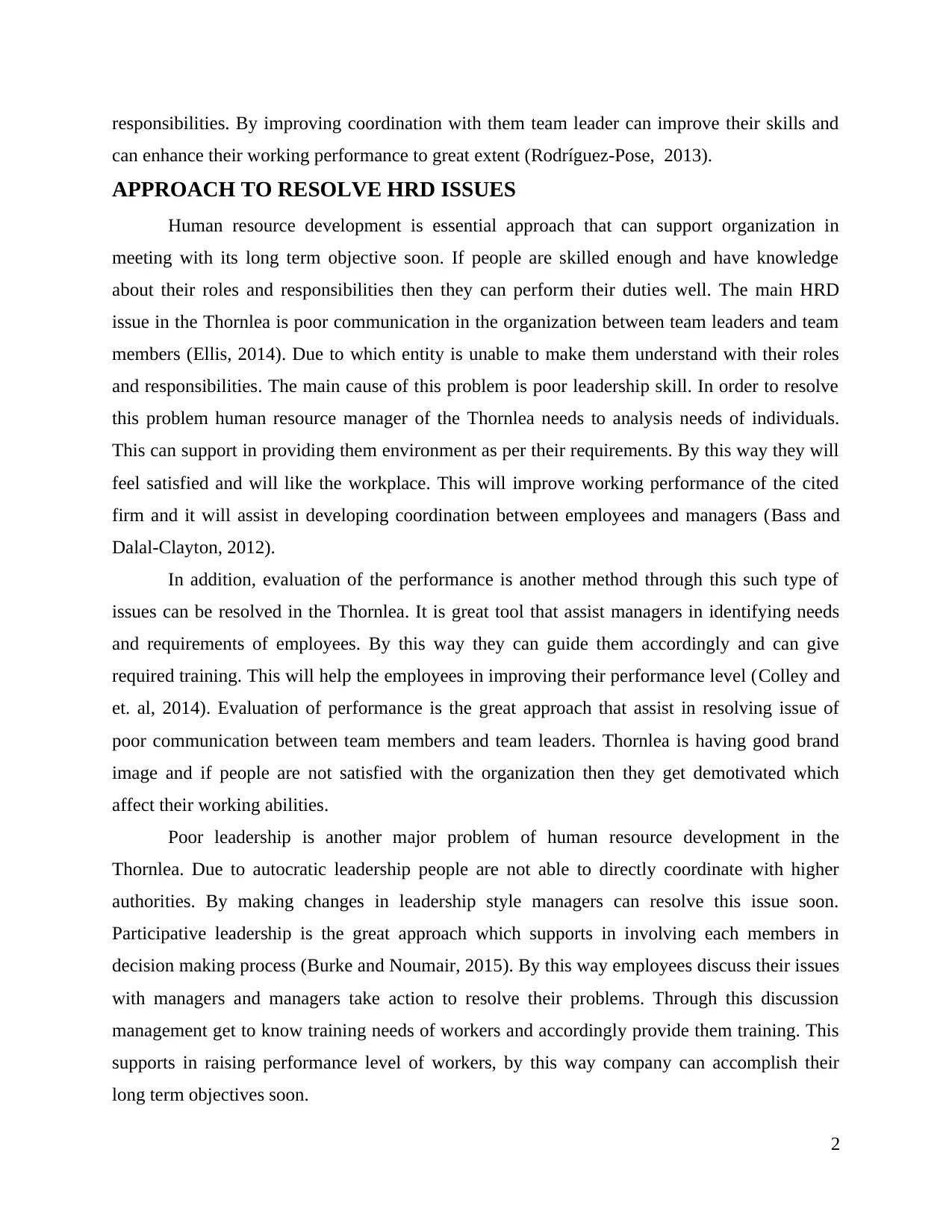
responsibilities. By improving coordination with them team leader can improve their skills and
can enhance their working performance to great extent (Rodríguez-Pose, 2013).
APPROACH TO RESOLVE HRD ISSUES
Human resource development is essential approach that can support organization in
meeting with its long term objective soon. If people are skilled enough and have knowledge
about their roles and responsibilities then they can perform their duties well. The main HRD
issue in the Thornlea is poor communication in the organization between team leaders and team
members (Ellis, 2014). Due to which entity is unable to make them understand with their roles
and responsibilities. The main cause of this problem is poor leadership skill. In order to resolve
this problem human resource manager of the Thornlea needs to analysis needs of individuals.
This can support in providing them environment as per their requirements. By this way they will
feel satisfied and will like the workplace. This will improve working performance of the cited
firm and it will assist in developing coordination between employees and managers (Bass and
Dalal-Clayton, 2012).
In addition, evaluation of the performance is another method through this such type of
issues can be resolved in the Thornlea. It is great tool that assist managers in identifying needs
and requirements of employees. By this way they can guide them accordingly and can give
required training. This will help the employees in improving their performance level (Colley and
et. al, 2014). Evaluation of performance is the great approach that assist in resolving issue of
poor communication between team members and team leaders. Thornlea is having good brand
image and if people are not satisfied with the organization then they get demotivated which
affect their working abilities.
Poor leadership is another major problem of human resource development in the
Thornlea. Due to autocratic leadership people are not able to directly coordinate with higher
authorities. By making changes in leadership style managers can resolve this issue soon.
Participative leadership is the great approach which supports in involving each members in
decision making process (Burke and Noumair, 2015). By this way employees discuss their issues
with managers and managers take action to resolve their problems. Through this discussion
management get to know training needs of workers and accordingly provide them training. This
supports in raising performance level of workers, by this way company can accomplish their
long term objectives soon.
2
can enhance their working performance to great extent (Rodríguez-Pose, 2013).
APPROACH TO RESOLVE HRD ISSUES
Human resource development is essential approach that can support organization in
meeting with its long term objective soon. If people are skilled enough and have knowledge
about their roles and responsibilities then they can perform their duties well. The main HRD
issue in the Thornlea is poor communication in the organization between team leaders and team
members (Ellis, 2014). Due to which entity is unable to make them understand with their roles
and responsibilities. The main cause of this problem is poor leadership skill. In order to resolve
this problem human resource manager of the Thornlea needs to analysis needs of individuals.
This can support in providing them environment as per their requirements. By this way they will
feel satisfied and will like the workplace. This will improve working performance of the cited
firm and it will assist in developing coordination between employees and managers (Bass and
Dalal-Clayton, 2012).
In addition, evaluation of the performance is another method through this such type of
issues can be resolved in the Thornlea. It is great tool that assist managers in identifying needs
and requirements of employees. By this way they can guide them accordingly and can give
required training. This will help the employees in improving their performance level (Colley and
et. al, 2014). Evaluation of performance is the great approach that assist in resolving issue of
poor communication between team members and team leaders. Thornlea is having good brand
image and if people are not satisfied with the organization then they get demotivated which
affect their working abilities.
Poor leadership is another major problem of human resource development in the
Thornlea. Due to autocratic leadership people are not able to directly coordinate with higher
authorities. By making changes in leadership style managers can resolve this issue soon.
Participative leadership is the great approach which supports in involving each members in
decision making process (Burke and Noumair, 2015). By this way employees discuss their issues
with managers and managers take action to resolve their problems. Through this discussion
management get to know training needs of workers and accordingly provide them training. This
supports in raising performance level of workers, by this way company can accomplish their
long term objectives soon.
2
Paraphrase This Document
Need a fresh take? Get an instant paraphrase of this document with our AI Paraphraser
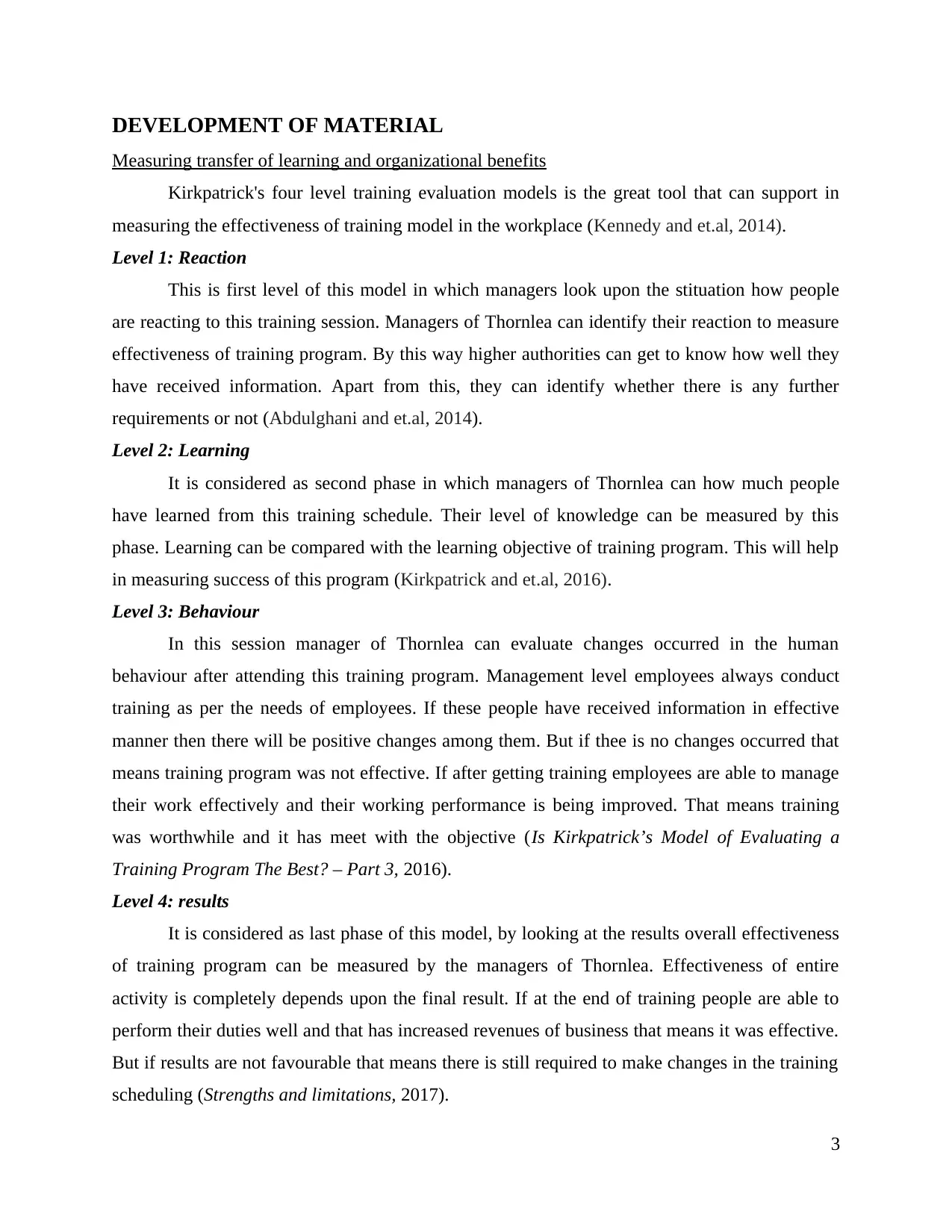
DEVELOPMENT OF MATERIAL
Measuring transfer of learning and organizational benefits
Kirkpatrick's four level training evaluation models is the great tool that can support in
measuring the effectiveness of training model in the workplace (Kennedy and et.al, 2014).
Level 1: Reaction
This is first level of this model in which managers look upon the stituation how people
are reacting to this training session. Managers of Thornlea can identify their reaction to measure
effectiveness of training program. By this way higher authorities can get to know how well they
have received information. Apart from this, they can identify whether there is any further
requirements or not (Abdulghani and et.al, 2014).
Level 2: Learning
It is considered as second phase in which managers of Thornlea can how much people
have learned from this training schedule. Their level of knowledge can be measured by this
phase. Learning can be compared with the learning objective of training program. This will help
in measuring success of this program (Kirkpatrick and et.al, 2016).
Level 3: Behaviour
In this session manager of Thornlea can evaluate changes occurred in the human
behaviour after attending this training program. Management level employees always conduct
training as per the needs of employees. If these people have received information in effective
manner then there will be positive changes among them. But if thee is no changes occurred that
means training program was not effective. If after getting training employees are able to manage
their work effectively and their working performance is being improved. That means training
was worthwhile and it has meet with the objective (Is Kirkpatrick’s Model of Evaluating a
Training Program The Best? – Part 3, 2016).
Level 4: results
It is considered as last phase of this model, by looking at the results overall effectiveness
of training program can be measured by the managers of Thornlea. Effectiveness of entire
activity is completely depends upon the final result. If at the end of training people are able to
perform their duties well and that has increased revenues of business that means it was effective.
But if results are not favourable that means there is still required to make changes in the training
scheduling (Strengths and limitations, 2017).
3
Measuring transfer of learning and organizational benefits
Kirkpatrick's four level training evaluation models is the great tool that can support in
measuring the effectiveness of training model in the workplace (Kennedy and et.al, 2014).
Level 1: Reaction
This is first level of this model in which managers look upon the stituation how people
are reacting to this training session. Managers of Thornlea can identify their reaction to measure
effectiveness of training program. By this way higher authorities can get to know how well they
have received information. Apart from this, they can identify whether there is any further
requirements or not (Abdulghani and et.al, 2014).
Level 2: Learning
It is considered as second phase in which managers of Thornlea can how much people
have learned from this training schedule. Their level of knowledge can be measured by this
phase. Learning can be compared with the learning objective of training program. This will help
in measuring success of this program (Kirkpatrick and et.al, 2016).
Level 3: Behaviour
In this session manager of Thornlea can evaluate changes occurred in the human
behaviour after attending this training program. Management level employees always conduct
training as per the needs of employees. If these people have received information in effective
manner then there will be positive changes among them. But if thee is no changes occurred that
means training program was not effective. If after getting training employees are able to manage
their work effectively and their working performance is being improved. That means training
was worthwhile and it has meet with the objective (Is Kirkpatrick’s Model of Evaluating a
Training Program The Best? – Part 3, 2016).
Level 4: results
It is considered as last phase of this model, by looking at the results overall effectiveness
of training program can be measured by the managers of Thornlea. Effectiveness of entire
activity is completely depends upon the final result. If at the end of training people are able to
perform their duties well and that has increased revenues of business that means it was effective.
But if results are not favourable that means there is still required to make changes in the training
scheduling (Strengths and limitations, 2017).
3
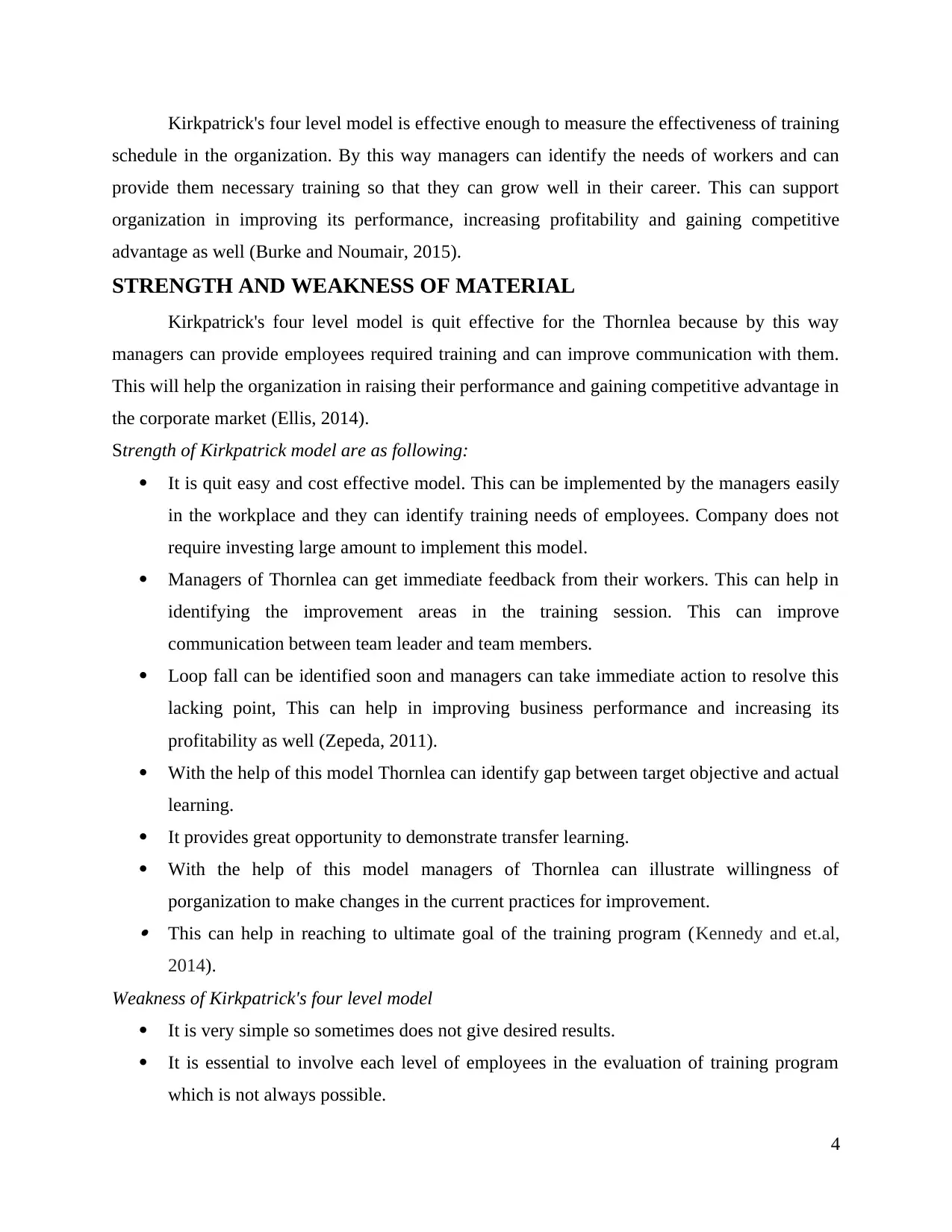
Kirkpatrick's four level model is effective enough to measure the effectiveness of training
schedule in the organization. By this way managers can identify the needs of workers and can
provide them necessary training so that they can grow well in their career. This can support
organization in improving its performance, increasing profitability and gaining competitive
advantage as well (Burke and Noumair, 2015).
STRENGTH AND WEAKNESS OF MATERIAL
Kirkpatrick's four level model is quit effective for the Thornlea because by this way
managers can provide employees required training and can improve communication with them.
This will help the organization in raising their performance and gaining competitive advantage in
the corporate market (Ellis, 2014).
Strength of Kirkpatrick model are as following:
It is quit easy and cost effective model. This can be implemented by the managers easily
in the workplace and they can identify training needs of employees. Company does not
require investing large amount to implement this model.
Managers of Thornlea can get immediate feedback from their workers. This can help in
identifying the improvement areas in the training session. This can improve
communication between team leader and team members.
Loop fall can be identified soon and managers can take immediate action to resolve this
lacking point, This can help in improving business performance and increasing its
profitability as well (Zepeda, 2011).
With the help of this model Thornlea can identify gap between target objective and actual
learning.
It provides great opportunity to demonstrate transfer learning.
With the help of this model managers of Thornlea can illustrate willingness of
porganization to make changes in the current practices for improvement. This can help in reaching to ultimate goal of the training program (Kennedy and et.al,
2014).
Weakness of Kirkpatrick's four level model
It is very simple so sometimes does not give desired results.
It is essential to involve each level of employees in the evaluation of training program
which is not always possible.
4
schedule in the organization. By this way managers can identify the needs of workers and can
provide them necessary training so that they can grow well in their career. This can support
organization in improving its performance, increasing profitability and gaining competitive
advantage as well (Burke and Noumair, 2015).
STRENGTH AND WEAKNESS OF MATERIAL
Kirkpatrick's four level model is quit effective for the Thornlea because by this way
managers can provide employees required training and can improve communication with them.
This will help the organization in raising their performance and gaining competitive advantage in
the corporate market (Ellis, 2014).
Strength of Kirkpatrick model are as following:
It is quit easy and cost effective model. This can be implemented by the managers easily
in the workplace and they can identify training needs of employees. Company does not
require investing large amount to implement this model.
Managers of Thornlea can get immediate feedback from their workers. This can help in
identifying the improvement areas in the training session. This can improve
communication between team leader and team members.
Loop fall can be identified soon and managers can take immediate action to resolve this
lacking point, This can help in improving business performance and increasing its
profitability as well (Zepeda, 2011).
With the help of this model Thornlea can identify gap between target objective and actual
learning.
It provides great opportunity to demonstrate transfer learning.
With the help of this model managers of Thornlea can illustrate willingness of
porganization to make changes in the current practices for improvement. This can help in reaching to ultimate goal of the training program (Kennedy and et.al,
2014).
Weakness of Kirkpatrick's four level model
It is very simple so sometimes does not give desired results.
It is essential to involve each level of employees in the evaluation of training program
which is not always possible.
4
⊘ This is a preview!⊘
Do you want full access?
Subscribe today to unlock all pages.

Trusted by 1+ million students worldwide
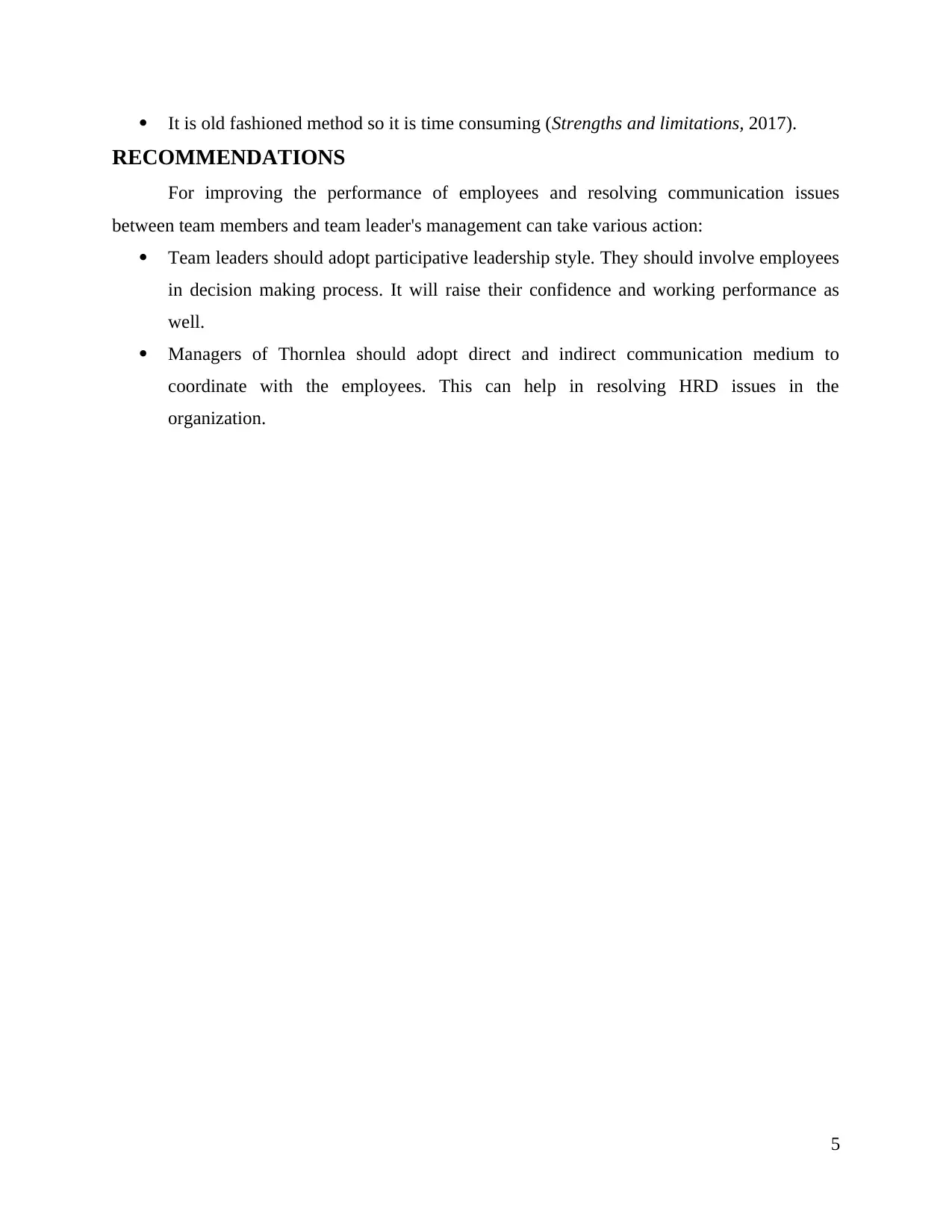
It is old fashioned method so it is time consuming (Strengths and limitations, 2017).
RECOMMENDATIONS
For improving the performance of employees and resolving communication issues
between team members and team leader's management can take various action:
Team leaders should adopt participative leadership style. They should involve employees
in decision making process. It will raise their confidence and working performance as
well.
Managers of Thornlea should adopt direct and indirect communication medium to
coordinate with the employees. This can help in resolving HRD issues in the
organization.
5
RECOMMENDATIONS
For improving the performance of employees and resolving communication issues
between team members and team leader's management can take various action:
Team leaders should adopt participative leadership style. They should involve employees
in decision making process. It will raise their confidence and working performance as
well.
Managers of Thornlea should adopt direct and indirect communication medium to
coordinate with the employees. This can help in resolving HRD issues in the
organization.
5
Paraphrase This Document
Need a fresh take? Get an instant paraphrase of this document with our AI Paraphraser
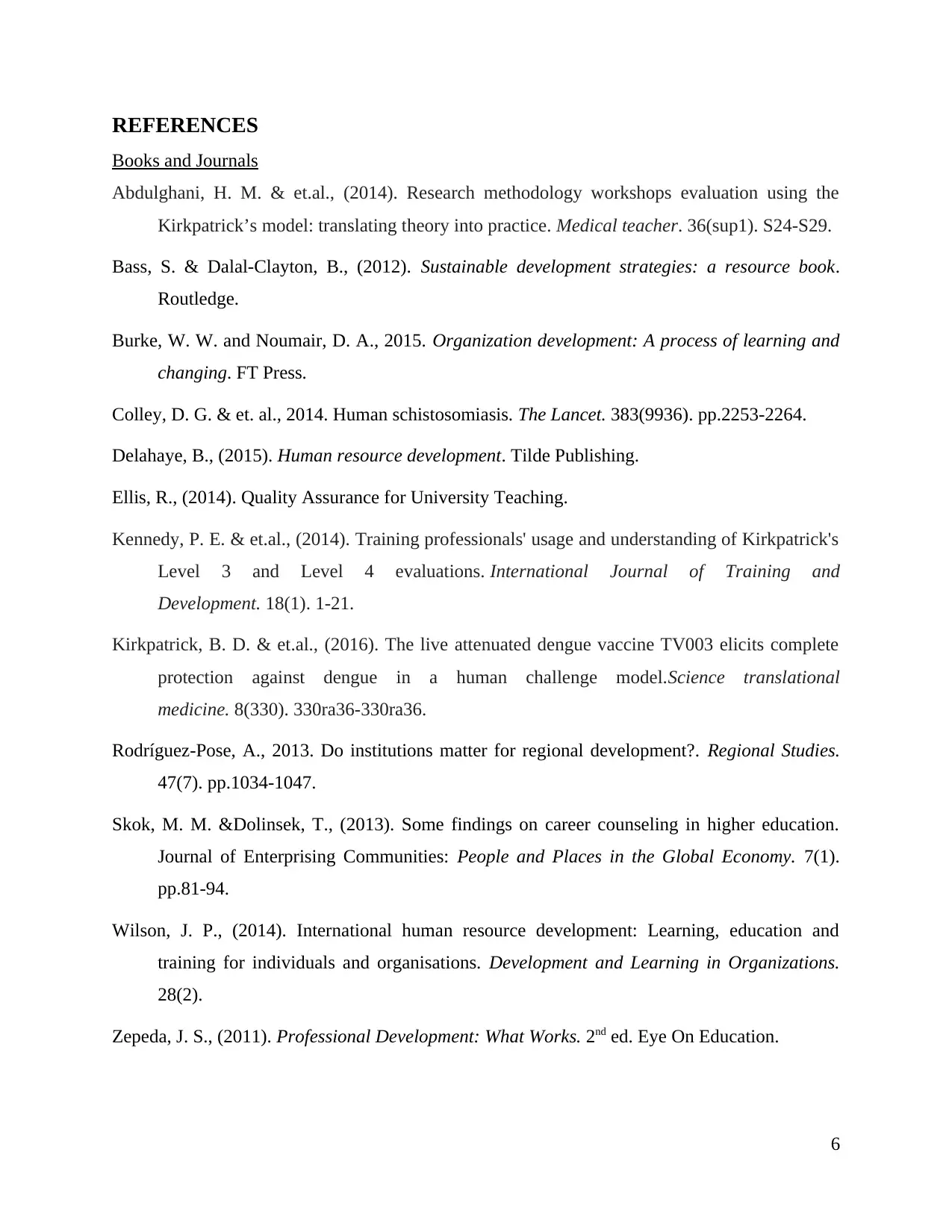
REFERENCES
Books and Journals
Abdulghani, H. M. & et.al., (2014). Research methodology workshops evaluation using the
Kirkpatrick’s model: translating theory into practice. Medical teacher. 36(sup1). S24-S29.
Bass, S. & Dalal-Clayton, B., (2012). Sustainable development strategies: a resource book.
Routledge.
Burke, W. W. and Noumair, D. A., 2015. Organization development: A process of learning and
changing. FT Press.
Colley, D. G. & et. al., 2014. Human schistosomiasis. The Lancet. 383(9936). pp.2253-2264.
Delahaye, B., (2015). Human resource development. Tilde Publishing.
Ellis, R., (2014). Quality Assurance for University Teaching.
Kennedy, P. E. & et.al., (2014). Training professionals' usage and understanding of Kirkpatrick's
Level 3 and Level 4 evaluations. International Journal of Training and
Development. 18(1). 1-21.
Kirkpatrick, B. D. & et.al., (2016). The live attenuated dengue vaccine TV003 elicits complete
protection against dengue in a human challenge model.Science translational
medicine. 8(330). 330ra36-330ra36.
Rodríguez-Pose, A., 2013. Do institutions matter for regional development?. Regional Studies.
47(7). pp.1034-1047.
Skok, M. M. &Dolinsek, T., (2013). Some findings on career counseling in higher education.
Journal of Enterprising Communities: People and Places in the Global Economy. 7(1).
pp.81-94.
Wilson, J. P., (2014). International human resource development: Learning, education and
training for individuals and organisations. Development and Learning in Organizations.
28(2).
Zepeda, J. S., (2011). Professional Development: What Works. 2nd ed. Eye On Education.
6
Books and Journals
Abdulghani, H. M. & et.al., (2014). Research methodology workshops evaluation using the
Kirkpatrick’s model: translating theory into practice. Medical teacher. 36(sup1). S24-S29.
Bass, S. & Dalal-Clayton, B., (2012). Sustainable development strategies: a resource book.
Routledge.
Burke, W. W. and Noumair, D. A., 2015. Organization development: A process of learning and
changing. FT Press.
Colley, D. G. & et. al., 2014. Human schistosomiasis. The Lancet. 383(9936). pp.2253-2264.
Delahaye, B., (2015). Human resource development. Tilde Publishing.
Ellis, R., (2014). Quality Assurance for University Teaching.
Kennedy, P. E. & et.al., (2014). Training professionals' usage and understanding of Kirkpatrick's
Level 3 and Level 4 evaluations. International Journal of Training and
Development. 18(1). 1-21.
Kirkpatrick, B. D. & et.al., (2016). The live attenuated dengue vaccine TV003 elicits complete
protection against dengue in a human challenge model.Science translational
medicine. 8(330). 330ra36-330ra36.
Rodríguez-Pose, A., 2013. Do institutions matter for regional development?. Regional Studies.
47(7). pp.1034-1047.
Skok, M. M. &Dolinsek, T., (2013). Some findings on career counseling in higher education.
Journal of Enterprising Communities: People and Places in the Global Economy. 7(1).
pp.81-94.
Wilson, J. P., (2014). International human resource development: Learning, education and
training for individuals and organisations. Development and Learning in Organizations.
28(2).
Zepeda, J. S., (2011). Professional Development: What Works. 2nd ed. Eye On Education.
6
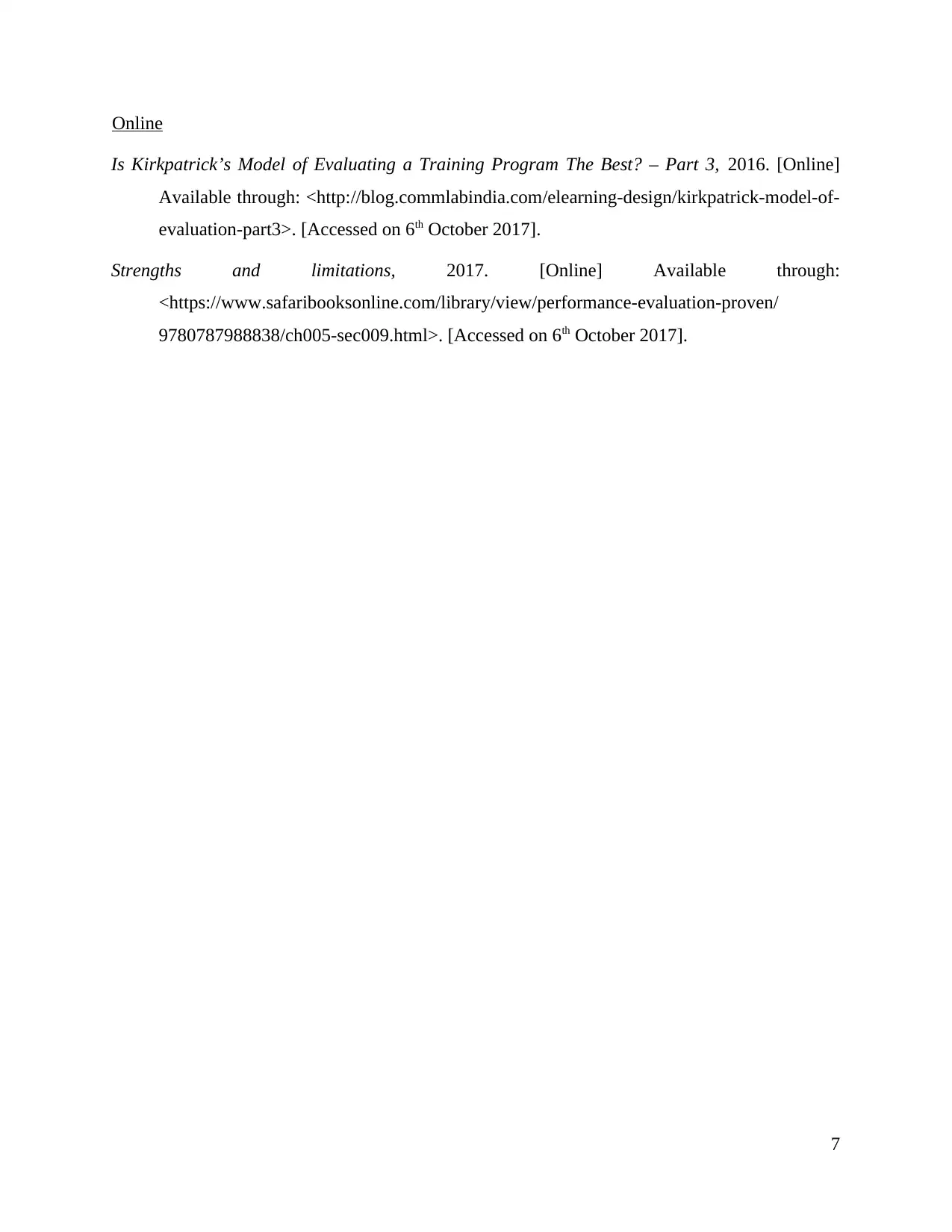
Online
Is Kirkpatrick’s Model of Evaluating a Training Program The Best? – Part 3, 2016. [Online]
Available through: <http://blog.commlabindia.com/elearning-design/kirkpatrick-model-of-
evaluation-part3>. [Accessed on 6th October 2017].
Strengths and limitations, 2017. [Online] Available through:
<https://www.safaribooksonline.com/library/view/performance-evaluation-proven/
9780787988838/ch005-sec009.html>. [Accessed on 6th October 2017].
7
Is Kirkpatrick’s Model of Evaluating a Training Program The Best? – Part 3, 2016. [Online]
Available through: <http://blog.commlabindia.com/elearning-design/kirkpatrick-model-of-
evaluation-part3>. [Accessed on 6th October 2017].
Strengths and limitations, 2017. [Online] Available through:
<https://www.safaribooksonline.com/library/view/performance-evaluation-proven/
9780787988838/ch005-sec009.html>. [Accessed on 6th October 2017].
7
⊘ This is a preview!⊘
Do you want full access?
Subscribe today to unlock all pages.

Trusted by 1+ million students worldwide
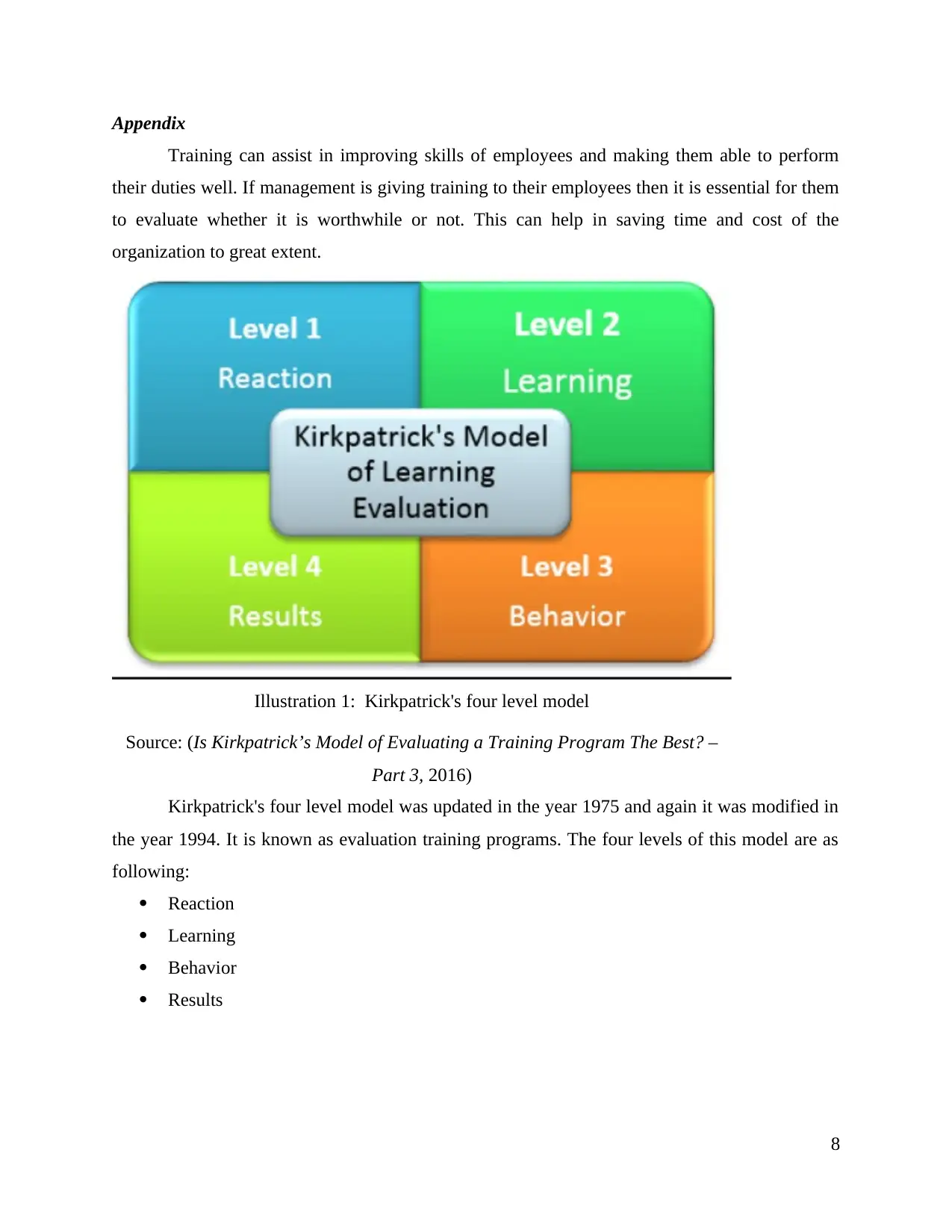
Appendix
Training can assist in improving skills of employees and making them able to perform
their duties well. If management is giving training to their employees then it is essential for them
to evaluate whether it is worthwhile or not. This can help in saving time and cost of the
organization to great extent.
Illustration 1: Kirkpatrick's four level model
Source: (Is Kirkpatrick’s Model of Evaluating a Training Program The Best? –
Part 3, 2016)
Kirkpatrick's four level model was updated in the year 1975 and again it was modified in
the year 1994. It is known as evaluation training programs. The four levels of this model are as
following:
Reaction
Learning
Behavior
Results
8
Training can assist in improving skills of employees and making them able to perform
their duties well. If management is giving training to their employees then it is essential for them
to evaluate whether it is worthwhile or not. This can help in saving time and cost of the
organization to great extent.
Illustration 1: Kirkpatrick's four level model
Source: (Is Kirkpatrick’s Model of Evaluating a Training Program The Best? –
Part 3, 2016)
Kirkpatrick's four level model was updated in the year 1975 and again it was modified in
the year 1994. It is known as evaluation training programs. The four levels of this model are as
following:
Reaction
Learning
Behavior
Results
8
1 out of 10
Related Documents
Your All-in-One AI-Powered Toolkit for Academic Success.
+13062052269
info@desklib.com
Available 24*7 on WhatsApp / Email
![[object Object]](/_next/static/media/star-bottom.7253800d.svg)
Unlock your academic potential
Copyright © 2020–2025 A2Z Services. All Rights Reserved. Developed and managed by ZUCOL.





